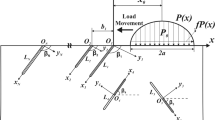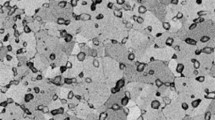Abstract
In rolling/sliding contact fatigue, it is known that the crack propagates at a characteristic angle θ=15–30 deg to the surface. To analyze the mechanism, however, the body force method has been widely used assuming 3D crack models for θ=45–90. In this study, therefore, the unknown body force densities are newly approximated by using fundamental density functions and polynomials. Then, a semi-elliptical crack model is analyzed for θ=15–90 under compressive residual stresses and Hertzian contact loads. The stress intensity factors K II, K III are calculated with varying the crack shape b/a, inclination crack angle θ, and crack face friction coefficient μ. The calculations show that the present method is useful for the analysis for θ=15–30 deg with high accuracy. It is seen that the K II-values when b/a→0 are larger than the ones when b/a=1 by 0–24% for both under compressive residual stress and Hertzian contact load. Regarding the maximum K II values under Hertzian contact load, the results of θ=15 deg are smaller than the ones of θ=45 deg by 23–34%. Regarding the amplitude of (K II max−K II min), the results of θ=15 deg are smaller than the ones of θ=45 deg by 4–24%. With increasing the value of friction coefficient μ for crack faces the value of K II decreases significantly. When the crack is short and the inclination angle θ is small, the value of friction coefficient f for Hertzian contact load largely affect the K II value.
Similar content being viewed by others
References
Bower, A.F. (1988). The influence of crack face friction and trapped fluid on surface initiated rolling contact fatigue cracks. Trans. ASME J. Tribol. 110, 704–711.
Hadamard, J. (1923). Lectures on Caunchy's Problem in Linear Partial Differential Equations. Yale University Press, Yale.
Hanson, M.T. and Keer, L.M. (1992). An analytical life prediction model for the crack propagation occurring in contact fatigue failure. ASLE Trans. 35, 451–461.
Hasebe, H. and Inohara, S. (1980). Stress analysis of a semi-infinite plate with an oblique edge crack. Ingenieur-Archiv 49, 51–62.
Ichimaru (1994). Studies on rolling contact fatigue from the standpoints of contact mechanics and fracture mechanics. Triborogist 39, 600–607 (in Japanese).
Ichimaru, K., Hamasaki, S. and Murakami, Y. (1992). A semi-circular surface crack subjected to rolling/sliding Hertzian contact. Stress Intensity Factors Handbook (edited byMurakami, Y.) Vol. 3, Pergamon Press, Londen, 816–836.
Isida, M. (1979). Tension of a half plane containing array of cracks, branched cracks emanating from sharp notches. Trans. Japan Society of Mechanical Engineers 45, 306–317 (in Japanese).
Kaneta, M., Yatsuzuka, H. and Murakami, Y. (1985). Mechanism of crack growth in lubricated rolling/sliding contact. ASLE Trans. 28, 407–414.
Kaneta, M., Suetsugu, M. and Murakami, Y. (1986). Mechanism of crack growth in lubricated rolling/sliding spherical contact. Trans. ASME, Journal of Applied Mechanics 53, 354–360.
Keer, L.M. and Bryant, M.D. (1983). A pitting model for rolling contact fatigue. Trans. ASME, J. Lubr. Technol. 105, 198–205.
Kobayashi (1996). Variation of mixed modes stress intensity factors of an inclined semi-elliptical surface crack.Master thesis, Kyushu Institute of Technology (in Japanese).
Mindlin, R.D. (1936). Force at a point in the interior of a semi-infinite solid. Physics 7, 195–202.
Murakami, Y. (1985). Analysis of stress intensity factors of modes I, II and III inclined surface cracks of arbitrary shape. Engng. Frac. Mech. 22, 101–114.
Murakami, Y., Kaneta, M. and Yatsuzuka, H. (1985). Analysis of surface crack propagation in lubricated rolling contact. ASLE Trans. 28, 60–68.
Murakami, Y., Sakae, C. and Ichimaru, K. (1994). Three dimensional fracture mechanics analysis of a pit formation mechanism under lubricant rolling-sliding contact loading. ASLE Trans. 37, 445–454.
Nisitani, H. (1967). The two-dimensional stress problem solved using an electric digital computer. Journal of the Japan Society of Mechanical Engineers 70, 627–632 (in Japanese) [1968, Bulletin of Japan Society of Mechanical Engineers 11, 14-23].
Nisitani, H. (1975). Stress intensity factor for the tension of a semi-infinite plate having an oblique or a bent edge crack. Trans. Japan Society of Mechanical Engineers 41, 1103–1111 (in Japanese).
Nisitani, H. and Murakami, Y. (1974). Stress intensity factor of an elliptical crack and semi-elliptical crack in plates subjected to tension. International Journal of Fracture 10, 353–368.
Noda, N.-A. and Miyoshi, S. (1996). Variation of stress intensity factor and crack opening displacement of a semi-elliptical surface crack. International Journal of Fracture 75, 19–48.
Noda, N.-A. and Oda, K. (1992). Numerical solution of the singular integral equations in the crack analysis using the body force method. International Journal of Fracture 58, 285–304.
Noda, N.-A., Kobayashi, K. and Yagishita, M. (1999). Variation of mixed modes stress intensity factors of an inclined semi-elliptical surface crack. International Journal of Fracture (in press).
Smith, J.O. and Liu, C.G. (1953). Stress due to tangential and normal loads on an elastic solid with application to some contact stress problems. Journal of Applied Mechanics 20, 1157–166.
Tokumoto, H. (1981). An inclined semi-ellipticl surface crack in a semi-infinite body under tension. Master thesis, Kyushu University (in Japanese) [1983, Prelim. Proc. 36th Annual Meeting of Japan Soc. Mech. Engrs, 838, 4–6 (in Japanese)].
Way, S. (1935). Pitting due to rolling contact. Trans. ASME, J. Appl. Mech. 2, A49–A58.
Author information
Authors and Affiliations
Rights and permissions
About this article
Cite this article
Noda, NA., Yagishita, M. & Kihara, T. Effect of crack shape, inclination angle, and friction coefficient in crack surface contact problems. International Journal of Fracture 105, 367–389 (2000). https://doi.org/10.1023/A:1007688027669
Issue Date:
DOI: https://doi.org/10.1023/A:1007688027669




